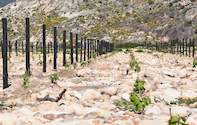Soil types in South Africa differ greatly. Some are very sandy, others have more clay and then there is rocky soil. Soil differs not only in appearance and colour, but also according to the nutrients and water-holding capacity.

Sandy and rocky soils can hold much less nutrients and water than clay soil. Furthermore, the amount of organic matter in the soil plays a very important role.
The characteristics of certain grape cultivars can be more prominent if grown in a particular soil. A combination of climate, terrain, rock knowledge and soil type contributes to the delivery of high quality wines, but the environmental conditions and soil type also affect the style of the wines.
It is therefore extremely important to know what the type of soil is in order to manage the best properties of the soil and to produce high quality wines. To determine the soil type is a very complicated and specialized task. In order to obtain the information, profile pits must be dug. These profile pits must be dug across the specific area and a complete soil analysis should be done by an expert.
Sandy Soil
Soil with a clay content of less than 6% has little resistance to root growth, but the main disadvantages of this soil type is its poor water-holding capacity and nutrient deficiency. Therefore, sandy soil should be watered more frequently and fertilizers should be applied regularly.
A large amount of irrigation water evaporates from this type of surface. With the relatively large sand grains, water drain quickly through the soil. Water conservation can be achieved by means of a cover crop or mulch - a thick layer of plant material on the surface - to reduce evaporation. Growing weeds extract much of the available water and nutrients, so the planting of cover crops and weed management are ideal farming practices with sandy soil.
The addition of organic material in the form of compost increases the humus in the soil and thus the water-holding capacity. The best irrigation for sandy soil is through micro or drip systems with a short irrigation cycle. Although sandy soil is fine and loose, it can become very dense and compacted after a lot of rain and vehicle traffic. Regular cultivation of sandy soil with a plough or disc harrow can destroy the structure.
Clay Soil
Clay soil is usually found next to rivers where it is mostly left behind by water or floods. Clay soil has a good water-holding capacity and a lot of nutrients and vines grown in this type of soil are typically very vigorous. The soil particles are very fine and large differences occur in the different layers.
Clay soil sometimes looks like a sandwich where the layers are separated by a coarse sand layer. The big difference in texture prevents good root penetration, as well as water distribution. Water moves through the clay and through the sand layer into the subsoil, but the roots do not penetrate the layer of coarse sand. Tillage in clay soils should be thoroughly planned to prevent compaction.
The water content of clay soil is very important when planning to mechanically cultivate the vineyard. Soil compaction can be caused by vehicle movement if the clay is too wet. In clay soil, organic material will promote better drainage and aeration. If the soil is too dry, large clusters can form. The problem soil layers should be thoroughly mixed with a delving plough.
Rocky Soil
This type of soil is very common in the supposedly topsoil. It is also called dorbank or ‘koffie klip’. Good soil preparation is essential in order to remove segmented, impenetrable layers that occur at varying depths. These layers can limit root penetration. Soil preparation in rocky areas is usually costly as large and expensive equipment needs to be used to sometimes remove the top layer.
Then the hard dorbank is ploughed with a subsoil plough or ripper. However, care should be taken not to again compact the already prepared soil. Rocky soil that is well prepared has a better holding capacity for nutrients and water.
By Vinpro